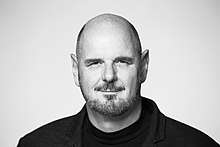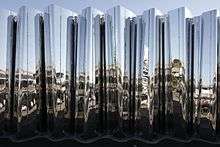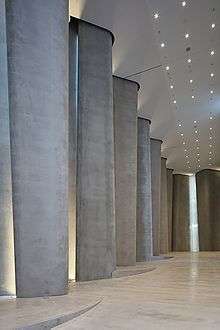Andrew Patterson (architect)
| Andrew Patterson | |
|---|---|
 | |
| Born |
12 June 1960 Waikato |
| Nationality | New Zealander |
| Education | Kings College, Auckland; School of Architecture, University of Auckland |
| Occupation | Architect |
| Known for | Patterson Associates, formed 1990 |


Andrew Patterson (born 12 June 1960) is a New Zealand Architect and director of Patterson Associates, based in Auckland, New Zealand. Born in the Waikato region, Patterson completed a Bachelor of Architecture degree at The University of Auckland in 1984 and started his own practice at age 26.
The Geyser building, in Auckland is the recipient of New Zealand’s only 6 Green Star (rating).[1] Other notable building projects include the Michael Hill Golf Clubhouse in Queenstown the Mai Mai House [2] the New Zealand pavilion at the Frankfurt Book Fair and the Len Lye centre in New Plymouth which was opened in 2015. In 1988 Patterson represented New Zealand at the New Breed Architectural Exhibition in Sydney and received his first National Award for Architecture. He is Fellow of the New Zealand Institute of Architects (FNZIA).[3]
Architectural philosophy
Patterson says his architectural philosophy is an extension of the surrounding physical ecology, that is underpinned by the Māori belief that people are a natural off spring of the land and sky.[4] [5]
This philosophy rejects traditional western distinctions between natural and man made environments.[6][7] Patterson has been vocal in pushing for greater use of indigenous New Zealand stories and symbols in the design of public buildings.[8] The Geyser building is an example in which [9] Patterson uses a pattern derived from the tassles of the korowai or traditional Māori cloak on the façade.[10] His interest in Māori culture is also evident in the Anvil building which used "cloud forms as conceptual drivers" relating to the Māori creation myth of Ranginui and Papatuanuku.[11]
Len Lye Centre
The Len Lye Centre, an extension of the Govett Brewster Art Gallery in New Plymouth, New Zealand was opened on 25 July 2015. Len Lye (5 July 1901 – 15 May 1980), was a Christchurch born, New Zealand artist known primarily for his experimental films and kinetic sculpture. This is the first gallery in New Zealand to be dedicated to a single artist.[12] Patterson Associates developed the design using patterns in the ecology of the project’s environments to drive design elements. [13] The folded surface reflects and refracts its surroundings which draws parallels with the work of the late artist who is also well known for his kinetic sculptures, many of which move or bend with tiny variations in air flow. The building is clad with locally sourced stainless steel. Stainless steel was Len Lye’s preferred sculptural material. [14] [15] The buildings most obvious ‘feature’ its reflective stainless steel colonnade which has been generated as an extruded Polynesia koru pattern (linked to Māori design) that encircles the whole centre.[16] Gaps between the folds in the facade allow a controlled amount of light through. [17] The building’s facade has become the backdrop for many of the regions selfie photographs. The glossiness of the material noted to confuse modern cameras auto focusing mechanisms. [18] The constraints of the architecture have been criticised as only four Len Lye sculptures can be shown at one time. [19]
Notable projects
- Len Lye Centre, New Plymouth (2015)
- Christchurch Botanic Garden Centre, Christchurch (2014)
- Scrubby Bay House, Banks Peninsula (2014)
- Geyser, Auckland (2012)
- Frankfurt Book Fair Pavilion, Frankfurt (2012)
- Seascape Retreat, Banks Peninsula (2011)
- Anvil Building, Auckland (2011)
- Local Rock House, Waiheke Island, Auckland (2011)
- Parihoa House, Auckland (2009)
- The Michael Hill Clubhouse, Arrowtown (2008)
- Mai Mai House, Auckland (2008)
- Cumulus, Auckland (2003)
- D72, Auckland (1996)
- Knight-Klisser House, Auckland (1992)
- Axis Building, Auckland (1991)
Awards
- World Architecture Awards finalist (Len Lye centre) 2016;
- Distinguished Alumni Award, University of Auckland 2013;
- Supreme Award, NZ Interior Awards (NZ pavilion Frankfurt Book Fair) 2013;
- 21 for 21 Award, World Architecture News, 2011;
- NZIA Architecture Award (Local Rock House), 2011;
- World Architecture Festival Shortlist (Sports & Leisure) 2008 and World Architecture Festival Shortlist (Houses) 2008;
- NZIA National and Supreme award for architecture (Hills Golf Clubhouse), 2008;
- NZIA National Award for architecture (Mai Mai House), 2008;
- NZIA National Award for architecture (AJ Hackett Bungy Visitor Centre), 2008;
- NZIA Award for architecture (Stratus), 2005;
- NZIA Supreme Award for architecture (Cumulus), 2003;
- NZIA Award for architecture (Site 3), 2002
References
- ↑ "Geyser Building New Zealand Green Building Council". New Zealand Green Building Council.
- ↑ "NZ designs among worlds best". Stuff.co.nz.
- ↑ "NZIA fellow". NZIA.
- ↑ "Individual Happiness". World Architecture News 2011.
- ↑ "Maori culture". New Zealand.com.
- ↑ "Ted Talks Andrew Patterson". You Tube.
- ↑ "NZIA Awards". NZIA.
- ↑ "Why we should stop getting Aussies to design our buildings". Idealog.
- ↑ "Geyser Building". Architecture Now.
- ↑ "Geyser Building, Architecture Now". Architecture Now.
- ↑ "Anvil Building". Architecture Now.
- ↑ "Len Lye the man behind the art". Taranaki Daily News.
- ↑ "len-lye centre". e-architect.
- ↑ "Pattersons Associates Len Lye Museum New Zealand Folded Mirrored Facade". Dezeen.
- ↑ "Govett Brewster Art Gallery Re-opens with permanent home for Len Lye". Art Daily.
- ↑ "Maori design a key influence on Len Lye Centre". Radio NZ.
- ↑ "Pattersons Associates Len Lye Museum New Zealand Folded Mirrored Facade". Dezeen.
- ↑ "The Re-aunching of Len Lye". Architectureau.
- ↑ "Only big enough to show four sculptures at one time". Taranaki Daily News.